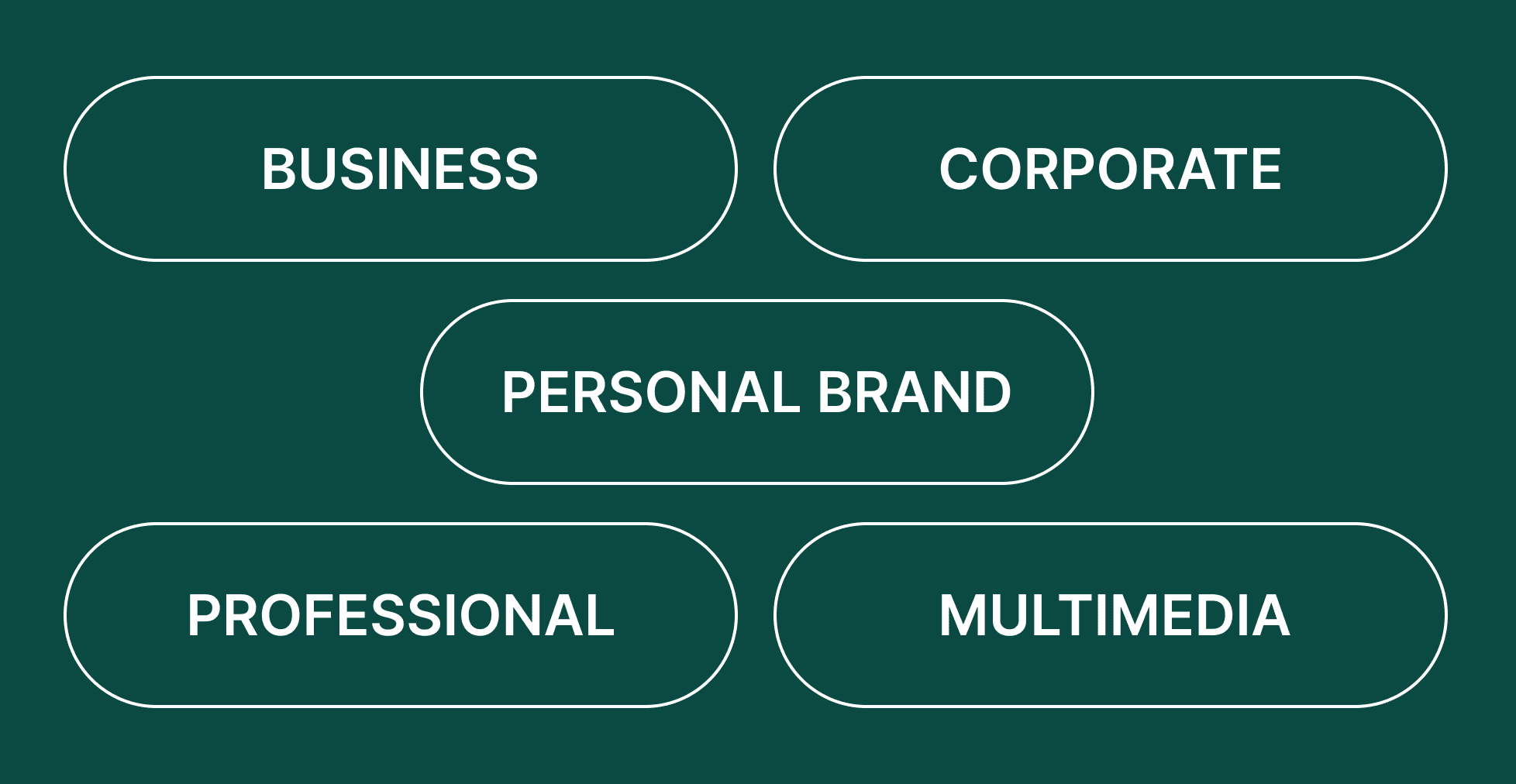Key takeaways:
- Some of the most popular types of blogs include personal, lifestyle, food, tech, travel, fashion, and finance. Each one attracts a different kind of reader.
- Use different post formats, such as how-to guides, listicles, reviews, and interviews, to keep your content interesting and appeal to more readers.
- Choosing the right blog type depends on your goals and interests. Consider what you want to achieve and pick a blog type that fits.
Even with social media, short videos, and AI content booming, blogging is still one of the best ways to reach audiences and earn money online. As of 2025, there are over 600 million blogs across the internet, and bloggers can earn a few hundred dollars to over $100,000 per month through ads, sponsorships, and affiliate programs.
If you’re planning to start a blog, or optimize an existing one, chances are you want pageviews—and profits. But just like in business, choosing the wrong model means wasted time, effort, and money.
That’s why we’ve put together the most popular types of blogs and discussed what makes each one unique. By the end, you’ll know which blog type is right for you.
TL;DR: There are many types of blogs you can start, ranging from personal to affiliate, all of which are relatively easy to launch and have the potential to generate income. Whatever sparks your interest in blogging—whether it’s a passion, a side hustle, or a combination of both—the right choice depends on your goals, available time, and long-term plans.
What are the different types of blogs?
Listed below are the most popular blog types you can easily start and monetize:
- Personal blogs
- Lifestyle blogs
- Business blogs
- News blogs
- Personal finance blogs
- Sports blogs
- Fashion blogs
- Food blogs
- Health and fitness blogs
- DIY craft blogs
- Parenting blogs
- Technology blogs
- Beauty blogs
- Art and design blogs
- Political blogs
- Personal development blogs
- Travel blogs
- Photography blogs
- Literature blogs
- Gaming blogs
- Religion blogs
- Affiliate blogs
Personal blogs
One of the oldest and most authentic types of blogs, personal blogs often start out as online diaries. They revolve around the blogger’s life stories, reflections, and moments that resonate with readers. And that’s the power of storytelling: it creates connection. Stories are an effective communication tool for your blog, especially when they’re honest and relatable.
There’s no fixed niche here. You can write about parenting, relationships, career, or even small daily joys. What really matters is the voice behind the blog. Readers stick around because they feel like they know you.
A great example is Cup of Jo, a long-running personal blog by Joanna Goddard. Originally a lifestyle journal, it’s now a favorite for readers interested in parenting, relationships, travel, and food.

Personal blog topics:
- Reflections on motherhood or family life
- Career lessons and personal growth
- Daily routines, habits, and lifestyle changes
- Mental health, grief, or healing journeys
- Everyday musings and life updates
Best suited for:
- Writers with a distinctive personal voice
- Anyone looking to document their life experiences
- Bloggers who want to build a community around shared stories
- Creatives or thought leaders growing a personal brand
Ways to monetize your personal blog:
- Partnering with lifestyle or wellness brands for sponsored blog posts
- Promoting affiliate links to favorite products or books
- Launching a newsletter with subscriber perks
- Offering digital products like eBooks or guides
- Displaying ads or working with ad networks once traffic volume increases
Lifestyle blogs
One of the most popular types of blogs, lifestyle blogging offers a curated glimpse into the blogger’s way of life, from morning routines and wellness habits to travel diaries and home decor tips. What sets lifestyle blogging apart is its versatility. It lets you weave together multiple interests into one cohesive brand.
Lifestyle is also one of the highest-earning and highest-traffic blogging niches, and understandably so. It’s personal yet aspirational, which is why people come for inspiration on how to live better, look better, or feel better.
Take Wit&Delight, for example. This popular blog covers everything from career tips to wellness and is built around empowering millennial women.
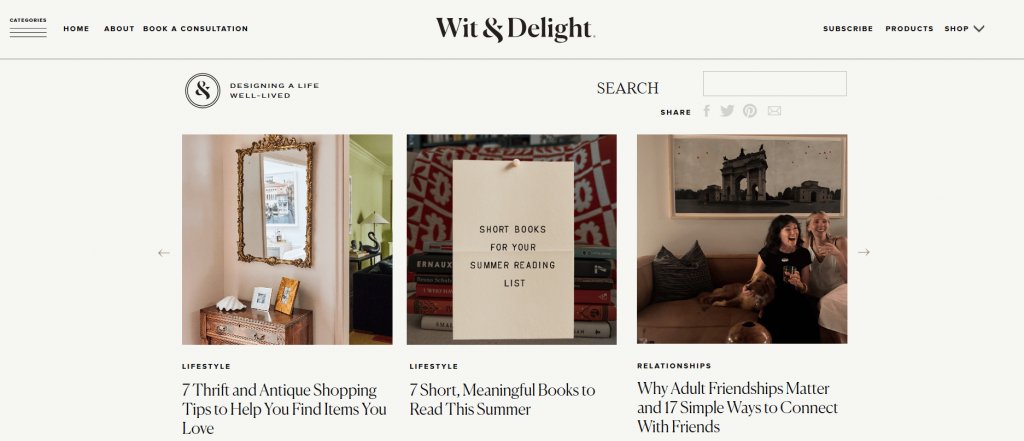
Lifestyle blog topics:
- Wellness, fitness, and self-care routines
- Home organization and decor ideas
- Travel guides and packing tips
- Fashion and seasonal outfit ideas
- Productivity and work-life balance content
- Sustainable living or minimalist practices
Best suited for:
- Content creators with a wide range of lifestyle interests
- Influencers or brands with a visual aesthetic
- Bloggers who want to connect through relatability and aspiration
- People who enjoy writing about habits, routines, and lifestyle hacks
Ways to monetize your lifestyle blog:
- Partnering with lifestyle and wellness brands for sponsored blog posts
- Promoting affiliate links for fashion, beauty, or home products
- Creating downloadable planners, templates, or digital guides
- Launching branded products (candles, apparel, etc.)
- Monetizing through YouTube or Instagram as extensions of the blog
Business blogs
For many entrepreneurs, blogs are problem solvers. They rely on them to stay ahead of industry changes or learn a new tool. That demand makes blogging a viable strategy for companies, too.
To add, websites and blogs are among the top marketing channels driving ROI for B2B brands.
HubSpot’s blog, for example, is one of the most successful today because of the value it offers to businesses—covering useful advice on marketing, sales, and customer service. Their content builds authority by teaching, not selling, and that’s what makes it so effective.
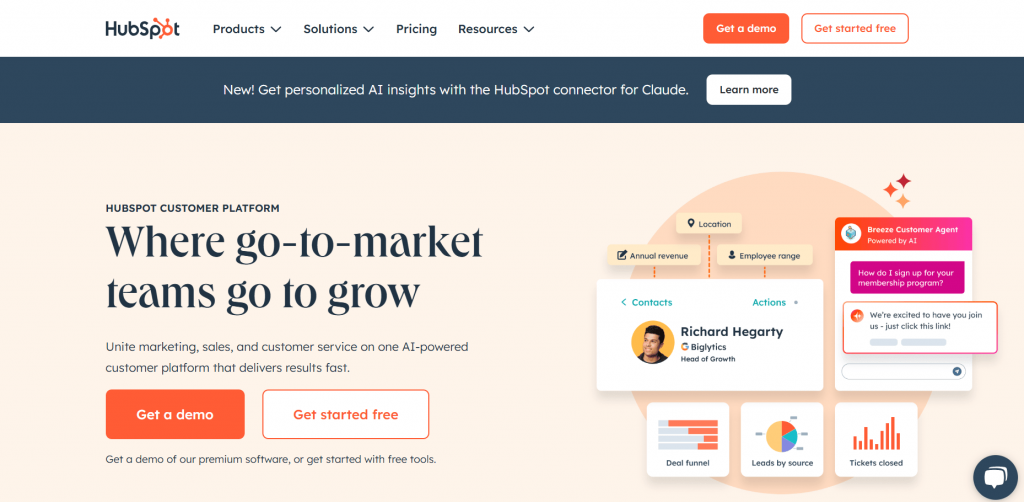
Business blog topics:
- Digital marketing and sales strategy
- Leadership, productivity, and growth hacks
- Industry updates and expert commentary
- Tool comparisons and how-to guides
- eCommerce trends, challenges, and solutions
Best suited for:
- Small businesses or startups building authority
- Agencies, consultants, and B2B service providers
- SaaS and tech companies educating their audience
- Professionals offering insights from experience
Ways to monetize your business blog:
- Building an email list and offering premium content
- Hosting workshops, paid webinars, or online courses
- Using affiliate links for business tools
- Selling templates, eBooks, or guides
News blogs
News blogs are go-to resources for global headlines to niche updates. If you love tracking what’s trending or always have something to say about current events, a news blog might be perfect.
Unlike traditional media outlets, news blogs today give you the freedom to focus on specific topics and share insights. You can write short roundups, real-time coverage, or deep-dive explainers. Just remember: readers rely on you for their news, especially in the morning. That’s why you must be timely, accurate, and insightful.
BBC News perfectly illustrates this approach. It blends breaking updates with detailed analysis and live reporting to keep readers informed around the clock.
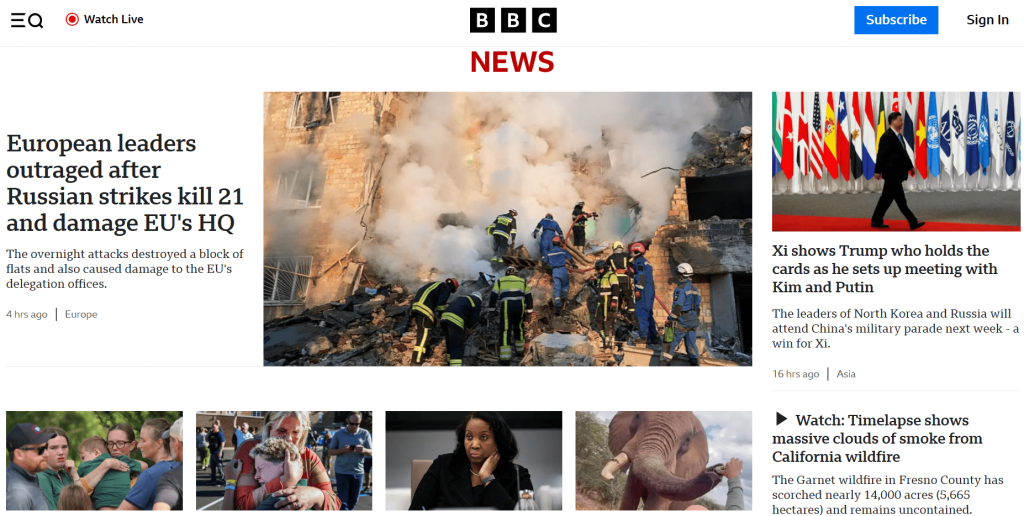
News blog topics:
- Breaking tech, finance, or political headlines
- Industry-specific trends (e.g., AI, fashion, gaming)
- Local news, city developments, or school updates
- Opinion pieces and analysis
- Event coverage or press release summaries
Best suited for:
- People with a pulse on fast-moving industries
- Local reporters and journalists
- Experts with strong opinions or inside knowledge
- Bloggers who can post frequently and quickly
Ways to monetize your news blog:
- Displaying banner ads with high-traffic articles
- Offering premium newsletter subscriptions
- Hosting sponsored interviews or thought leadership content
- Using affiliate links (e.g., tools, books, event tickets)
- Partnering with media networks
Personal finance blogs
With the growing demand for financial literacy, finance blogs have surged in popularity. In fact, searches for budgeting jumped by 40% from 2021 to 2023. If you’ve got a knack for simplifying financial topics or sharing your personal money wins (and fails), starting a niche blog in finance could be the best option for you.
Finance blogs help people manage their money and plan for the future. But you don’t need to be a certified financial advisor to be helpful. Many personal finance bloggers share tips on how to budget, invest, or pay off debt. Just keep your content clear, honest, and reader-focused.
Successful blogs like Money Crashers cover everything from accurate money-saving tips to investing, retirement planning, and frugal living. Their comprehensive guides and approachable tone make complex financial topics easy for readers to understand.
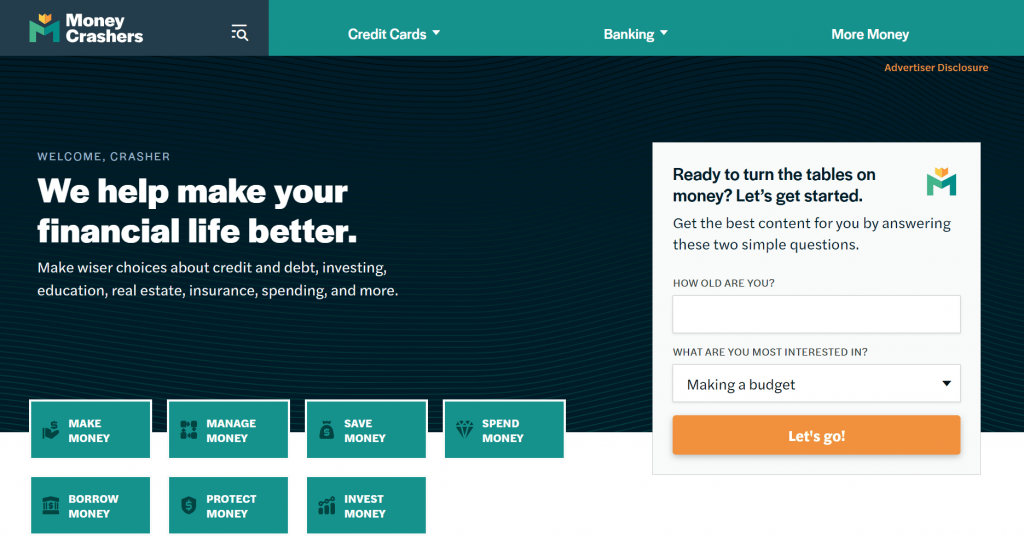
Personal finance blog topics:
- Budgeting for beginners or families
- Paying off debt (credit cards, student loans)
- Building an emergency fund
- Retirement and investing 101
- Saving money on everyday expenses
- Side hustles and income streams
Best suited for:
- Financial coaches or advisors
- Budgeting pros or frugal living advocates
- Bloggers passionate about helping others with money
Ways to monetize your personal finance blog:
- Using affiliate links for financial tools, apps, or services
- Partnering with banks or fintech brands for sponsored posts
- Selling digital products (e.g., spreadsheets, eBooks)
- Launching an online course or membership
- Displaying banner ads on high-traffic evergreen guides
Sports blogs
The sports blogging niche is massive. For instance, ESPN, the highest-traffic sports website in the world, attracts over 356 million monthly visitors.
Sports blogs give fans a way to follow their favorite teams, explore niche sports, and get deeper insights than they’d find in the usual headlines.
But you don’t need to cover every sport under the sun. Most sports blogs focus on a specific league like the NBA or NFL, a local team, or a fan-favorite topic like fantasy football. Meanwhile, other reputable sports websites get creative with rankings, predictions, athlete interviews, or behind-the-scenes stories.
To build a large audience, a sports blog needs to check all these boxes: high-quality analysis, timely updates, and fan community engagement. Take Bleacher Report, for example. It built its success on bold opinions, multimedia content, and a strong social media presence.
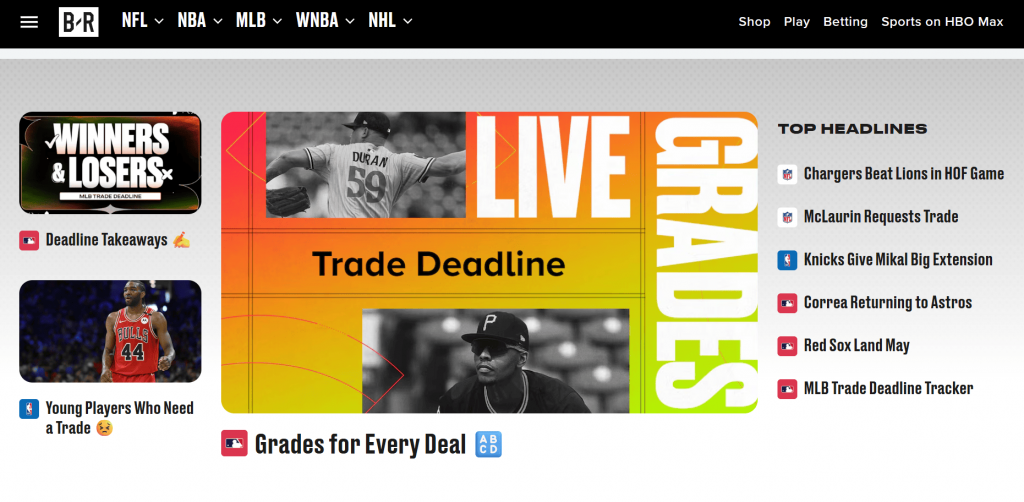
Sports blog topics:
- Game previews and match analyses
- Player profiles and interviews
- Fantasy sports advice and strategies
- Breaking news and transfer rumors
- Local sports and amateur leagues
Best suited for:
- Sports fans and analysts
- Former athletes or coaches
- Fantasy sports enthusiasts
- Writers who can cover games and trends regularly
Ways to monetize your sports blog:
- Using affiliate links for sports gear and tickets
- Partnering with sports brands or events for sponsored content
- Displaying ads during major sports seasons
- Selling fan merchandise or exclusive content
- Hosting podcasts or video commentary
Fashion blogs
Turns out, seeing a fashion product on blogs and social media platforms really works. About 75% of people say they’ve made a purchase that way. That kind of influence makes fashion blogging one of the most visually impactful and monetizable niche blog types today.
This type of blog spans everything from personal style diaries and runway recaps to trend predictions, styling guides, and even sustainable fashion journeys. There’s simply a stylish lane for every niche, whether you’re into sustainable style, high fashion, or budget-friendly shopping.
One helpful tip? Create a fashion blog and let your personality shine through visuals and content.
Imagine landing on a blog as bold and joyful as Color Me Courtney. With its vibrant design, the blog mirrors the founder’s playful personality while offering style tips, lifestyle content, and travel stories.
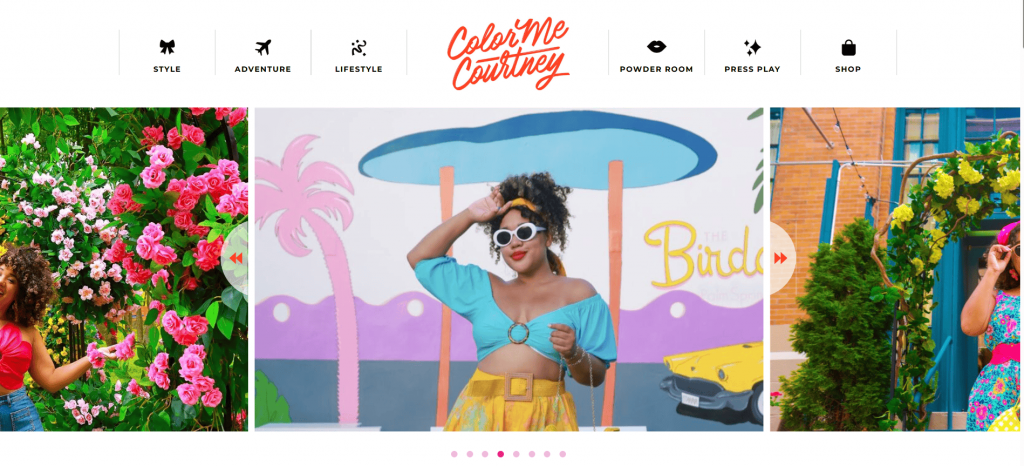
Fashion blog topics:
- Outfit-of-the-day (OOTD) blog posts or personal lookbooks
- Trend forecasts and seasonal must-haves
- Thrift finds, wardrobe challenges, and styling on a budget
- Sustainable fashion or capsule wardrobe tips
- Reviews of fashion week collections or beauty products
Best suited for:
- Aspiring fashion influencers or stylists
- Personal shoppers or boutique owners
- People with a passion for style, beauty, or self-expression
- Sustainability advocates promoting conscious fashion
Ways to monetize your fashion blog:
- Partner with clothing or beauty brands for sponsored content
- Use affiliate links (via RewardStyle, Amazon, etc.)
- Offer virtual styling services or fashion courses
- Launch your own product line or curated collections
- Monetize through TikTok, Pinterest, or Instagram integrations
Food blogs
Among the many types of blogs, food blogs are a favorite among readers and creators alike. From home-cooked recipes, restaurant reviews, and niche diets like vegan or gluten-free, there’s always a hungry audience out there. Case in point: food content is one of the most shared topics on Pinterest, with over 18 billion recipe pins saved annually.
What makes food blogging exciting is its flexibility. You can document your culinary experiments, build a brand around a specific cuisine, or share your food adventures as a traveling critic.
And it’s not just a passion project. Monetization comes naturally here, especially if you pair great content with social media strategy and striking visuals. Just like how Love & Lemons does it. Their blog posts feature bright, appetizing food photography.

Food blog topics:
- Step-by-step recipes with photos or videos
- Restaurant reviews and local food guides
- Product reviews (kitchen tools, ingredients, meal kits)
- Food trends and culinary travel diaries
- Cooking tips
Best suited for:
- Home cooks, bakers, or food enthusiasts
- Culinary professionals or chefs looking to build a personal brand
- Restaurant critics or food travelers
- Health-conscious eaters or those exploring niche diets (e.g., vegan, keto, gluten-free)
Ways to monetize your food blog:
- Partnering with brands for sponsored recipe content or product placement
- Using affiliate links for kitchen gadgets or ingredients
- Selling your own cookbook, recipe cards, or meal planning guides
- Exploring banner advertising
Health and fitness blogs
Health and wellness are among the most searched topics online. Over half of adults—58.5%, to be exact—look online for health or medical info. With so many people doing this, it’s no surprise that health blogs have become incredibly popular.
Starting a health and fitness blog is an impactful way to share knowledge or personal experience with an audience that’s actively looking for support and trustworthy information.
Most blogs in this niche often feature evidence-based content and personal stories to build trust and motivation. Some take a science-forward approach, whereas other bloggers lean on lived experience or coaching. Either way, they tend to prioritize content that readers can rely on in the long run.
Born Fitness stands out for its no-nonsense approach. Instead of bombarding readers with trends or jargon, it gives practical advice on training, nutrition, and recovery. The blog’s clean layout and authentic tone make it approachable for both beginners and advanced readers.
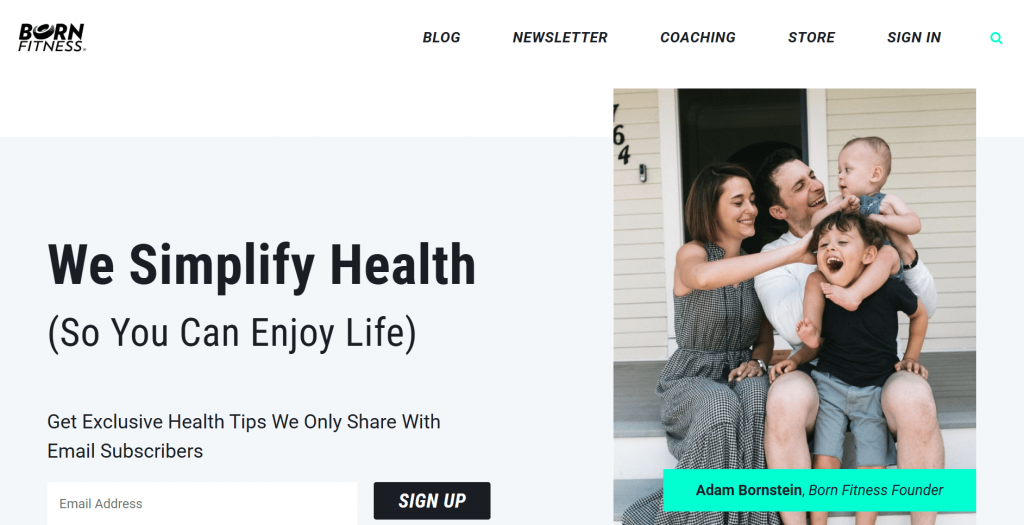
Health and fitness blog topics:
- Strength training and beginner workouts
- Smart nutrition and meal planning
- Fitness myths, trends, and fact-checks
- Stress management and mental wellness
- Reviews of fitness gear, wearables, or wellness apps
Best suited for:
- Personal trainers, health coaches, and wellness educators
- Dietitians or nutritionists looking to share practical advice
- Fitness enthusiasts chronicling their progress
- Mind-body practitioners and holistic health advocates
Ways to monetize your health and fitness blog:
- Selling digital fitness programs or coaching sessions
- Creating a members-only content hub or online challenge
- Partnering with wellness brands for sponsored content
- Promoting fitness gear or supplements through affiliate links
- Offering personalized plans or consultations
DIY craft blogs
Creativity is contagious, and DIY blogs are where it spreads. From upcycled home décor to handmade cards, these blogs offer endless ideas for people who love working with their hands.
In fact, nearly one in four U.S. adults said they enjoy DIY and arts & crafts as a regular hobby in 2024, based on Statista data. That kind of interest keeps DIY blogs buzzing with traffic and community engagement.
A longtime favorite in the creative blogging scene is A Beautiful Mess. Founded by sisters Emma Chapman and Elsie Larson, the blog features DIY projects, home décor tutorials, and lifestyle content.

DIY craft blog topics:
- Home décor projects using everyday items
- Holiday crafts and seasonal decorations
- Upcycling and thrift flips
- Handmade gifts and cards
- Art journaling, scrapbooking, and printables
Best suited for:
- Crafters and makers who love sharing tutorials
- Creatives who want to build a visual brand
- Hobbyists looking to turn passion into income
Ways to monetize your DIY craft blog:
- Selling printable patterns, templates, or craft kits
- Partnering with craft supply brands for sponsored content
- Offering online workshops or video courses
- Running ads or joining affiliate programs for tools and materials
Parenting blogs
Juggling the demands of raising children, work, self-care, and family is no easy feat. That’s why many parents turn to blogs for advice and encouragement. In fact, a lot of moms follow influencer moms on Facebook or visit bloggers’ pages.
This type of blog offers tips, honest conversations, and stories parents can relate to, which helps them feel less alone in their parenting journey. Such an approach is actually what makes these blogs so relatable and really valuable to all kinds of parents.
Helping to make the chaos feel manageable, Your Modern Family covers everything from easy family meals to creative kids’ activities. Best of all, its approachable tone and relatable content help families find practical solutions while celebrating everyday moments.
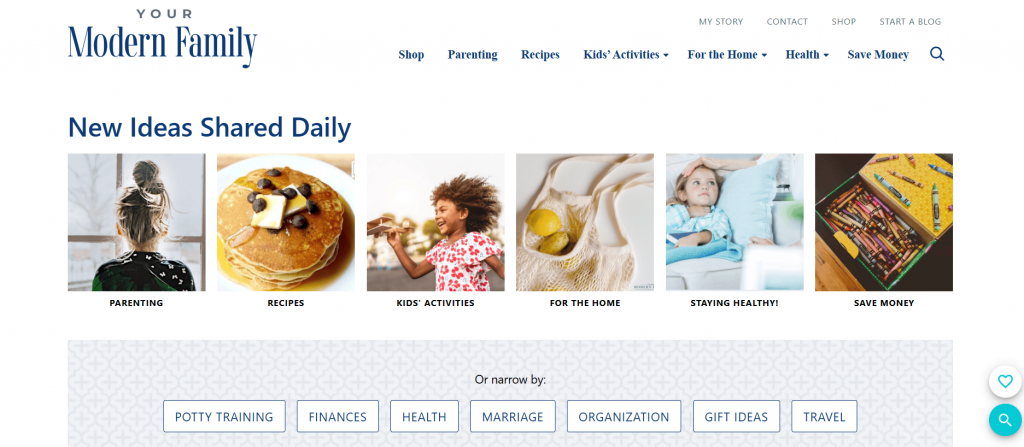
Parenting blog topics:
- Simple and healthy family recipes
- Fun and educational activities for kids
- Time management and organization tips for busy parents
- Honest discussions about parenting challenges
- Self-care and mental wellness strategies
Best suited for:
- Parents who want to share real experiences and advice
- Family lifestyle bloggers
- Experts focusing on child development or family health
Ways to monetize your parenting blog:
- Partnering with brands in the family, health, or education sectors for sponsored posts
- Recommending products with affiliate links, such as kids’ toys, books, or meal prep tools
- Creating and selling printables like chore charts or meal planners
- Expanding into video or podcast content to reach a wider audience
Technology blogs
Tech is moving faster than most people can keep up with. From new devices to software updates, there’s always something changing. Because of this, successful bloggers who break down complex ideas into simple terms have become go-to guides for many.
One thing you’ll notice among the most popular Google searches is that many are about tech. It’s further proof of how much people turn to the web to understand the latest gadgets, apps, and innovations.
One tech blog that consistently explains complex tech news into easy-to-understand insights is TechCrunch. It talks about everything from startup launches to industry shifts, which is also why both tech pros and curious readers rely on it.
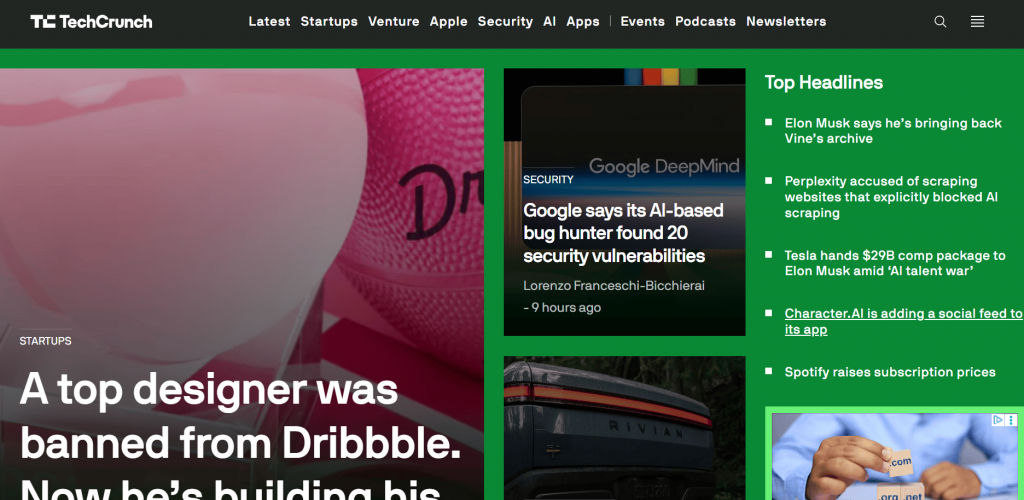
Technology blog topics:
- Product reviews (smartphones, laptops, wearables)
- How-to guides and troubleshooting tips
- Emerging tech trends (AI, blockchain, VR)
- Software and app recommendations
- Industry news and startup coverage
Best suited for:
- Tech enthusiasts who love exploring new gadgets
- Industry insiders and analysts
- Bloggers who enjoy explaining complex topics simply
- Readers looking for trustworthy tech advice
Ways to monetize your technology blog:
- Using affiliate marketing for tech products and software
- Partnering with tech brands and startups for sponsored content
- Displaying ads targeting tech-savvy audiences
- Offering paid tutorials, digital downloads, or exclusive newsletters
Beauty blogs
Many beauty bloggers today are earning more than just free products. According to a report, the average salary for a beauty blogger is around $40,000 per year. Put simply, this niche hits all these marks: creativity, influence, and income potential.
At their core, beauty blogs aim to educate and inspire. Some blogs focus on clean beauty or inclusive products, while others explore global trends, expert interviews, or DIY routines. Even better, they share real experiences and results, which you don’t always get from ads or influencer posts on social media platforms.
If you’re wondering how far this type of blog can take you, ReallyRee shows what’s possible when you focus on honest reviews and early product access. Offering product reviews, tutorials, and first-look launches, it helps readers decide what’s worth trying before they buy.
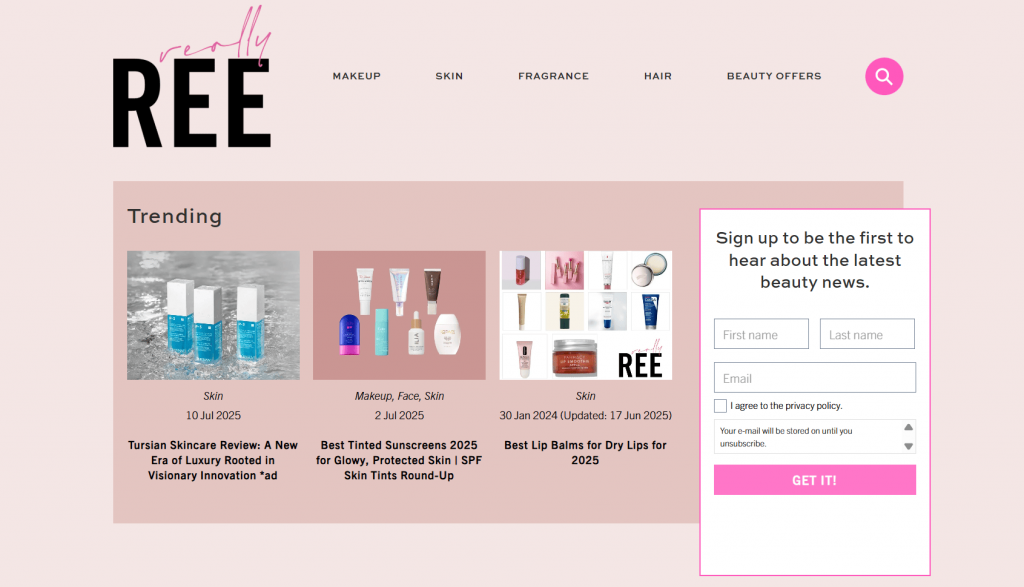
Beauty blog topics:
- Product reviews (makeup, skincare, haircare)
- Step-by-step tutorials and routines
- Ingredient deep-dives and skin science basics
- Beauty dupes and affordable alternatives
- Trends like Korean skincare, clean beauty, or minimalism
Best suited for:
- Beauty lovers who enjoy testing and recommending products
- Licensed professionals (estheticians, makeup artists)
- Skincare enthusiasts with personal journeys to share
Ways to monetize your beauty blog:
- Using affiliate links for beauty products (Amazon, Sephora, etc.)
- Partnering with skincare and makeup brands for sponsored posts
- Collaborating on product lines (e.g., branded brushes or skincare)
- Offering exclusive content or courses (e.g., makeup masterclasses, skincare guides)
Art and design blogs
If you’re an artist, illustrator, or designer, starting an art blog can be one of the easiest ways to grow your presence and connect with like-minded creatives. It can even turn your passion into income. No matter what kind of art you create, your blog can showcase your work, tell the stories behind your pieces, and even inspire fellow artists.
Besides showing off your portfolio, you can also teach new skills, offer tutorials, or highlight trends in the art world. Juxtapoz adopts this approach with style. It features and combines edgy visual art with culture and news to keep its readers inspired and engaged.

Art and design blog topics:
- Sketchbook tours and process videos
- Step‑by‑step tutorials (digital illustration, painting)
- Reviews of favorite art tools and materials
- Visual essays on design and art trends
- Creative challenges (e.g., “30-day drawing project”)
Best suited for:
- Freelance artists building their personal portfolio
- Illustrators, graphic designers, photographers
- Art students or hobbyists
Ways to monetize your art blog:
- Selling print or digital art (prints, stickers, commissions)
- Teaching online design workshops
- Using affiliate links for art supplies or software tools
- Partnering with brands in the art space for sponsored features
Political blogs
Sometimes you want a place where you can explore political ideas and share your honest opinion without holding back. Political blogs give you that chance. People from all sides of the debate use them to start conversations, question different views, and build support for causes that matter.
To make your blog stand out, focus on clear, well-researched content. Make complex issues easier to understand and invite readers to join the discussion.
One successful blog that does this well is Vox. It delivers thoughtful explanations and fresh perspectives on politics and current events. Vox also uses multimedia, such as videos and charts, to make complicated topics easier to grasp.
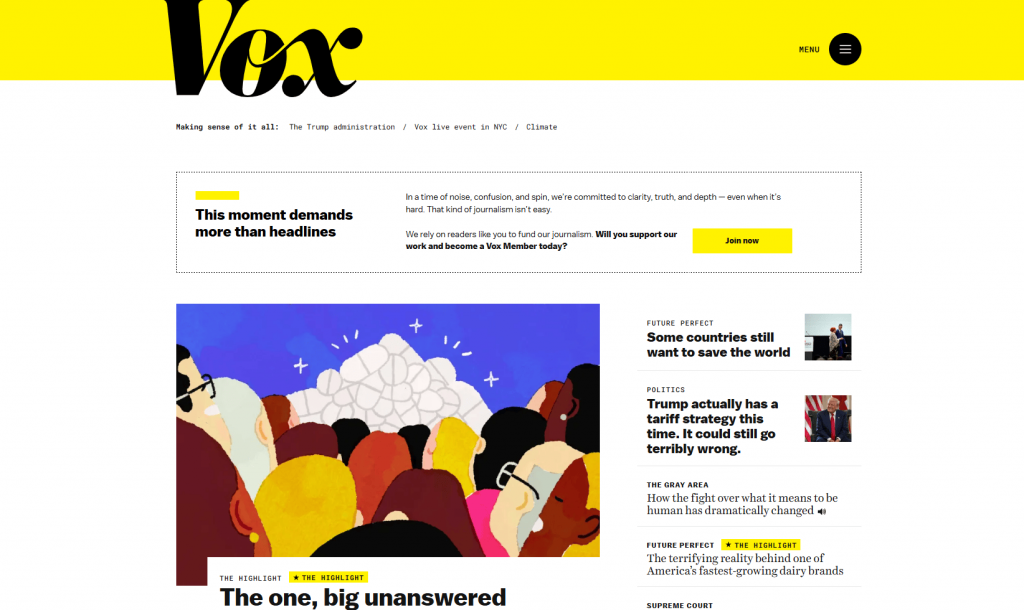
Political blog topics:
- Current events and breaking news
- Policy analysis and government actions
- Opinion and commentary
- Activism and social movements
- International affairs
Best suited for:
- People interested in politics and social issues
- Writers who enjoy research and analysis
- Activists and advocates
- Readers looking for clear explanations and fresh perspectives
Ways to monetize your political blog:
- Displaying ads targeting a political audience
- Partnering with nonprofits or campaigns for sponsored posts
- Offering paid newsletters with exclusive analysis
- Using affiliate marketing for books and documentaries
Personal development blogs
The personal development market was worth $45.2 billion in 2023 and is expected to grow to almost $74 billion by 2032. This steady rise shows more people want to improve themselves. That’s why personal development blogs are becoming a popular place to share advice and inspiration.
If you’re someone who loves helping others grow, a personal development blog gives you that platform. To get started, pick a few topics you’re passionate about and think about how your own experiences can offer useful lessons.
For instance, Tiny Buddha centers around personal stories and expert tips to help readers find calm, focus, and motivation in their daily lives.
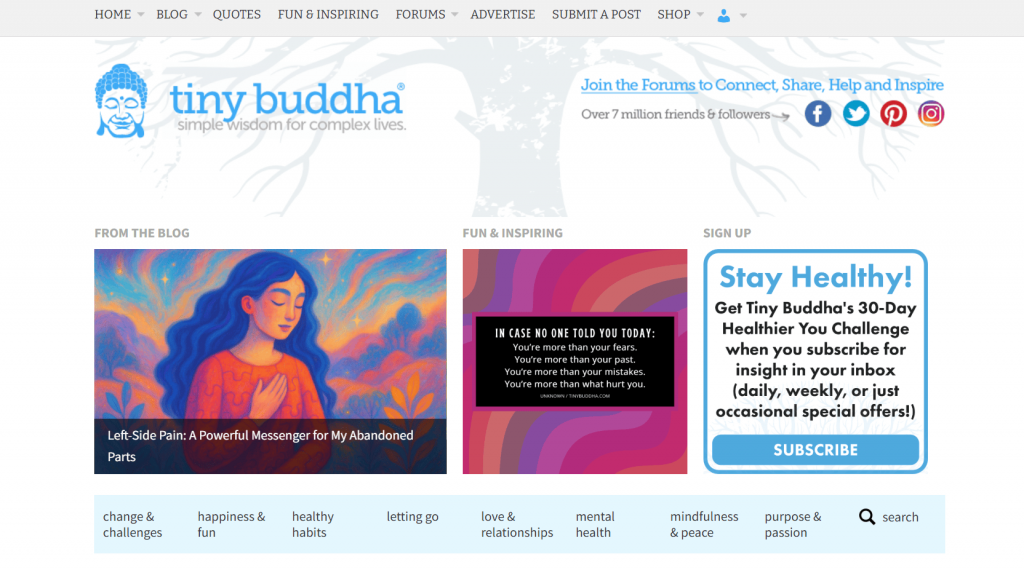
Personal development blog topics:
- Setting and achieving goals
- Building productive habits
- Mindfulness and stress relief
- Time management and motivation
- Mental health and self-care
Best suited for:
- Coaches and therapists
- Anyone passionate about growth and wellness
- Writers who enjoy sharing advice and stories
- Readers looking for practical tips and inspiration
Ways to monetize your personal development blog:
- Offering coaching or online courses
- Selling eBooks or workbooks
- Hosting webinars and workshops
Travel blogs
Travel blogs inspire millions of people to explore new places and cultures every year. Around 33% of US travelers read travel blogs when planning their trips, which proves how trusted and influential these blogs have become.
If you enjoy uncovering hidden gems, reviewing hotels, or sharing your travel adventures, you ought to start a travel blog. It’s a fantastic way to share your experiences and help others plan their own trips. To make your blog more professional, buy a custom domain like .travel.
If you want an idea of how to do it right, check out Adventurous Kate. She shares personal stories alongside practical travel tips. Her honest voice and detailed guides make her blog a favorite for those looking to explore the world.
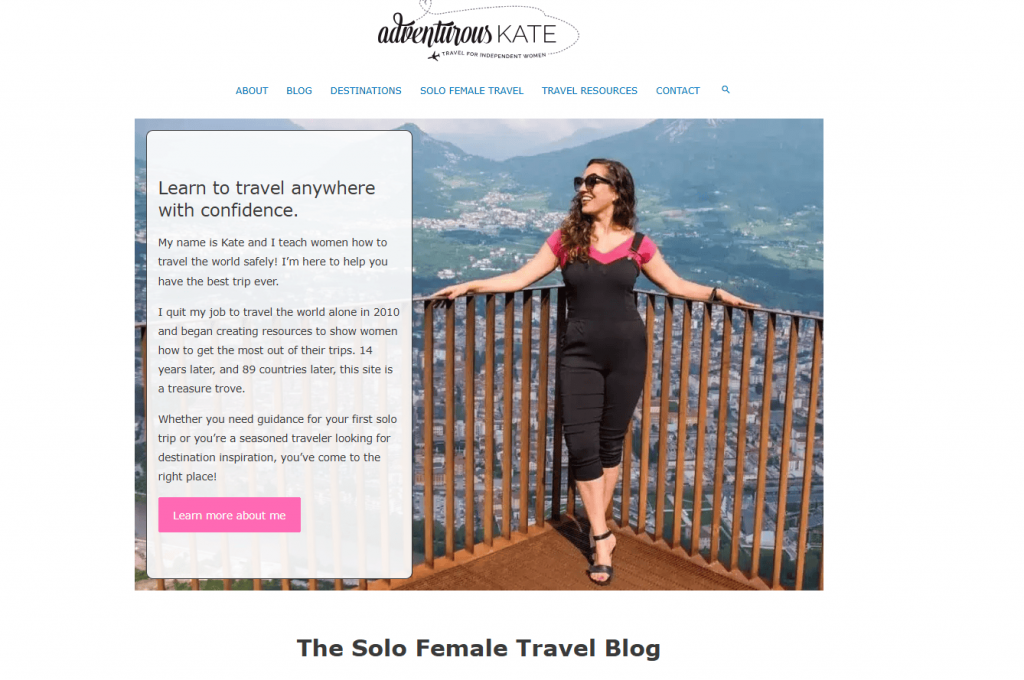
Travel blog topics:
- Destination guides and itineraries
- Travel tips and hacks
- Hotel and restaurant reviews
- Budget travel strategies
- Cultural experiences and stories
Best suited for:
- Frequent travelers and explorers
- Budget-conscious tourists
- Travel photographers and videographers
- People who love storytelling and sharing experiences
Ways to monetize your travel blog:
- Using affiliate links for travel gear and bookings
- Partnering on sponsored trips and brand collaborations
- Selling travel guides and eBooks
- Displaying ads and monetizing YouTube content
- Offering tours or travel planning services
Photography blogs
A photo can say a lot on its own. But sometimes, the story behind it makes it even better. A photography blog lets you do both. You can share your work, talk about your process, and offer helpful tips for fellow creatives.
It’s also a great way to connect with other photographers, show off your skills to potential clients, or teach what you’ve learned. It doesn’t matter if you’re into portraits, landscapes, street photography, or editing hacks. This type of blog gives your images a home.
And with so many easy-to-use photography website builders available, getting started is simpler than ever.
SLR Lounge shows how a photography blog can be both practical and educational. Along with gear reviews and lighting tips, it gives step-by-step guides that help readers understand the process behind each image.
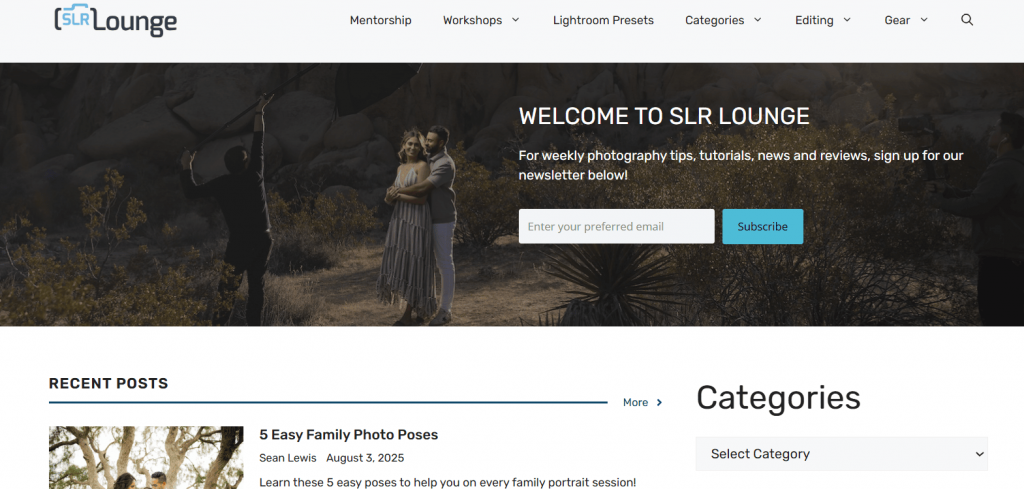
Photography blog topics:
- Camera and lens reviews
- Editing tips and tutorials
- Photography techniques and challenges
- Behind-the-scenes of photo shoots
- Photo stories and inspiration
Best suited for:
- Amateur and professional photographers
- Visual storytellers
- Photography gear enthusiasts
- People building a creative brand or portfolio
Ways to monetize your photography blog:
- Partnering with camera and accessory brands for sponsored content
- Selling presets, prints, or photography courses
- Using affiliate marketing for gear and software
- Offering photography services or workshops
Literature blogs
Love reading, writing, or talking about books? A literature blog lets you turn that passion into something bigger. You can share book reviews, write essays about themes or authors, or reflect on your own creative process. It’s a place to connect with fellow readers and writers who care about the written word.
And people are looking. Search engines remain the top way readers find book blogs, with social media coming in second. That means if you post consistently and apply the best SEO practices, your content has a good shot at reaching an engaged audience.
If you want to see how a blog can serve the literary community, look at Literary Hub. It brings together sharp essays, author insights, and the latest in publishing. No wonder it’s a favorite among book lovers and writers alike.
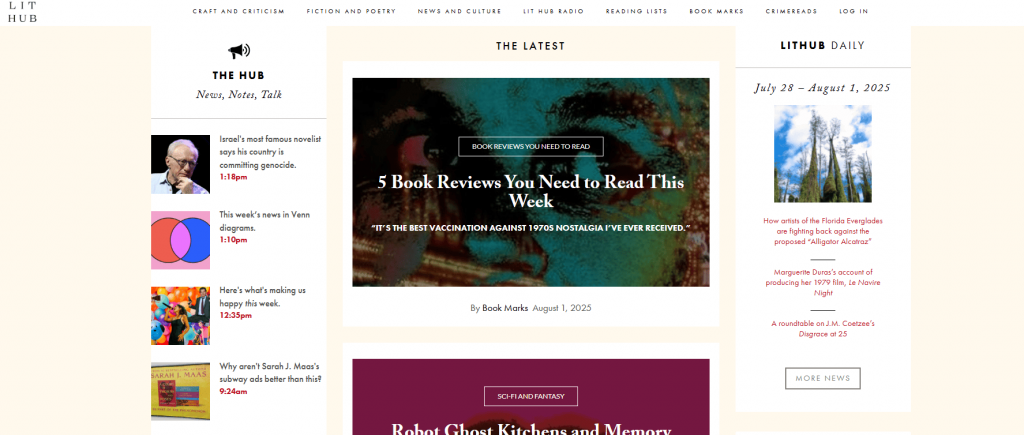
Literature blog topics:
- Book reviews or reading lists
- Writing advice or journaling reflections
- Deep dives into literary themes
- Author interviews or features
- Essays on publishing or the writing life
Best suited for:
- Writers building a personal brand
- Readers who enjoy long-form reflections
- Book lovers with strong opinions
- Students or teachers in the humanities
Ways to monetize your literature blog:
- Using affiliate links to promote books
- Building Patreon support from readers
- Writing guest posts or columns
- Promoting your own book or newsletter
Gaming blogs
Gaming is one of the biggest entertainment industries in the world, with about 3.32 billion active players globally. That means there’s a huge audience eager for news, reviews, tips, and lively discussions about everything from console exclusives to indie hits.
This type of blog covers the latest releases, gaming tips, fan discussions, culture, esports, and market trends. This makes it valuable to all kinds of players, from beginners to veterans.
Take Kotaku, for instance. It delivers breaking news, thoughtful features, and opinion pieces with an energetic and often humorous voice. Kotaku proves a gaming blog can educate and entertain at the same time.
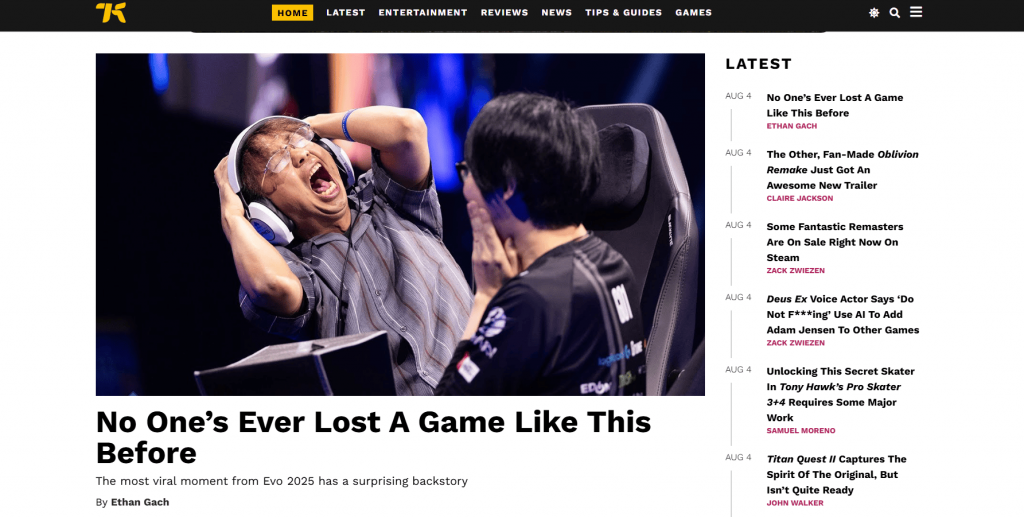
Popular gaming blog topics:
- New game reviews and previews
- Tips, tricks, and walkthroughs
- Esports news and tournament coverage
- Gaming hardware and accessories
- Industry trends and developer interviews
Best suited for:
- Avid gamers and esports fans
- Game reviewers and critics
- Streamers and content creators
- Tech enthusiasts interested in gaming gear
- Writers passionate about gaming culture and trends
Ways to monetize your gaming blog:
- Using affiliate links for gaming gear and digital downloads
- Partnering on sponsored content and game promotions
- Selling merchandise like branded apparel
- Offering premium gaming guides or tutorials
Religion blogs
Almost 40% of Americans use websites or apps to help with prayer, scripture reading, meditation, or practicing gratitude. This growing digital engagement shows how many people now turn to online spaces for spiritual growth and connection.
Religion blogs are a perfect fit for this trend. They provide guidance, inspiration, and a welcoming community where readers can explore faith in their own way. These blogs cover everything from daily devotionals and religious teachings to personal reflections and meaningful discussions on values and ethics.
Take Desiring God, for example. It’s rooted in Christian teachings, but it also encourages honest questions and open discussion. The content is clear and relatable, helping readers grow in their faith.

Religion blog topics:
- Daily devotionals and prayers
- Religious holidays and traditions
- Faith and spiritual experiences
- Ethical and moral discussions
- Meditation and mindfulness practices
Best suited for:
- Spiritual leaders and faith teachers
- Individuals sharing personal faith experiences
- People interested in exploring different religions
- Writers focused on theology and ethics
- Communities seeking encouragement and connection
Ways to monetize your religion blog:
- Offering online courses or workshops on spirituality
- Partnering with faith-based brands for sponsored content
- Selling religious books, art, or merchandise
- Displaying ads targeted to spiritual audiences
Affiliate blogs
Blogging is a top channel for affiliate marketing, with nearly 28% of brands choosing blogs over other platforms (aside from social media) to promote their products. That’s because readers trust well-written reviews and value honest, helpful recommendations.
Affiliate blogs help readers make smart buying decisions by reviewing and recommending products or services. These blogs can zero in on a specific niche, like camping gear or skincare, or cover broader markets like technology or home goods.
Many bloggers start with an Amazon affiliate website, which offers a huge range of products and a simple setup for earning commissions. Done right, affiliate blogs can become a reliable income stream, as long as your content stays honest and reader-focused.
That’s exactly how The Points Guy got its start—by sharing travel tips and credit card advice. Now it’s a massive platform with major brand partnerships, all built on helpful, reliable content.
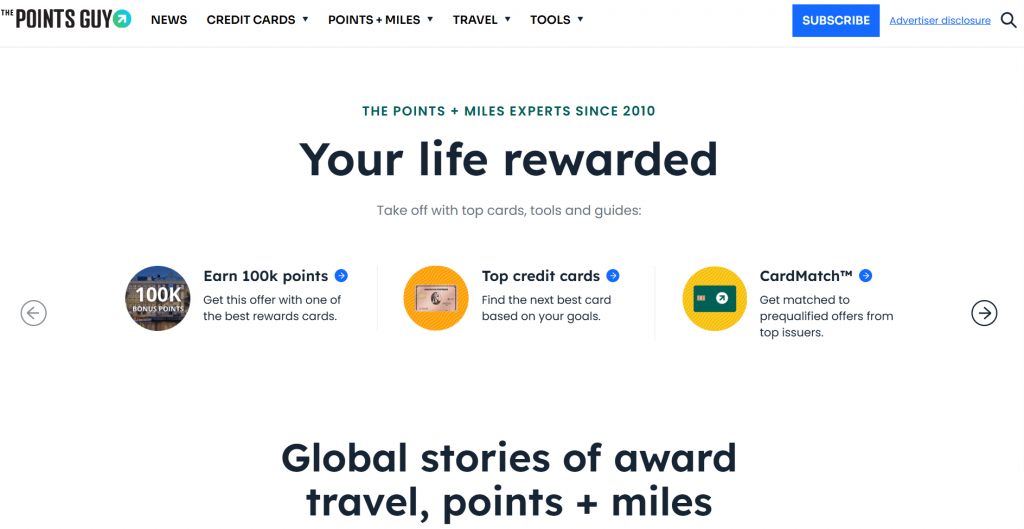
Affiliate blog topics:
- Product reviews and comparisons
- How-to guides featuring recommended tools or software
- Best-of lists (e.g., top headphones, must-have kitchen gadgets)
- Tutorials incorporating affiliate products
- Deals, discounts, and seasonal buying guides
Best suited for:
- Bloggers passionate about specific product categories
- Reviewers who value honesty and detail
- Entrepreneurs looking for passive income streams
- Content creators skilled at SEO and digital marketing
Ways to monetize your affiliate blog:
- Earning affiliate commissions from linked products
- Partnering with brands for sponsored posts or promotions
- Using email marketing to promote affiliate offers
- Selling digital products or courses that complement affiliate products
- Displaying ads to boost overall revenue
How to choose the right blog for you
Not sure which blog to start? The best one for you is a blog that aligns with your goals, your schedule, and your passions. To narrow down your options, ask yourself these three simple questions:
1. What’s your main goal?
Are you blogging to express yourself, build a brand, or make money?
- If you’re focused on writing blogs avid readers enjoy, personal, lifestyle, or hobby blogs are great for sharing your passion and creativity.
- If it’s for business or income, try niche blogs, affiliate blogs, or content-driven business blogs.
2. How much time can you commit?
- Do you have time to post often? Consider news, travel, or food-related blogs where fresh content is important.
- Short on time? Go for evergreen formats, like how-tos, tutorials, or product reviews, that don’t need constant updating.
3. Do you want to earn from your blog?
- If yes: explore affiliate blogs, niche sites, or business blogs with monetization built in.
- If not: focus on storytelling, personal growth, or community content without worrying about conversions.
What are the best blog post formats to start with?
Once you’ve decided what type of blog you want to create, the next step is figuring out the best way to present your content. After all, it affects how people read and interact with them, and some styles work better depending on what you want to achieve.
Here are a few popular blog formats to start with:
- How-to guides
- Listicles
- Comparison
- Product reviews
- Interviews
How-to guides
How-to guides are detailed posts that teach readers how to accomplish a specific task or solve a problem. Search trends show how-tos are among the most popular types of online content. Add to that, 77% of bloggers say how-to guides are their favorite kind of post to write.
Here are some examples of how-to guide blogs:
How to structure your how-to guide:
- Start with an introduction that states what the guide is about and what readers will learn.
- Step 1: [Title of the first step]. Describe the initial action in detail. Add images or videos if they help clarify the process.
- Step 2: [Title of the second step]. Outline the next action, again using visuals if they make it easier to understand.
- Continue with the remaining steps until you’ve covered the entire task.
- Finish with a conclusion that recaps the main points and offers any final suggestions or reminders.
Tips for writing a how-to guide:
- Base your guide on your own experience to offer practical tips that readers can rely on.
- Use clear steps and include screenshots or videos for visual learners.
- Organize the content logically to avoid confusion.
- Keep language simple and jargon-free.
Listicles
Humans naturally crave order, especially when life feels chaotic. An article in The Guardian says this is because lists break tasks into smaller chunks and make everything feel less stressful.
And that’s what makes listicles so effective. A listicle is an article organized as a series of numbered or bulleted points, with each item offering a brief explanation. This format breaks down information into easy-to-digest sections, which helps readers absorb content quickly.
Here are some examples of listicle blogs:
- Top 13 Most Common Domain Names in 2025
- Top Alternatives to Google Business Profile Websites
- Top 8 Social Media Marketing Trends To Watch in 2025
How to structure your listicle:
- Start with an introduction that explains the topic and why it’s worth discussing
- Item 1: [Title of first point]. Provide a clear explanation or tip and add visuals if helpful.
- Item 2: [Title of second point]. Share the next point with clear details.
- Continue listing all points.
- Finish with a conclusion that summarizes key takeaways and encourages readers to act.
Tips for writing a listicle:
- Pick topics that work well as lists, like tips, or reasons.
- Don’t overuse listicles—mix up your content to keep things fresh.
- Use clear, engaging headings for each point and include images when they add value.
- Make every item useful so readers walk away with something new.
Comparison
When readers face several options, they want a clear side-by-side comparison to help them decide. Comparison blogs provide exactly that: a detailed breakdown of two or more products, services, or ideas, highlighting their features, pros, cons, and value.
This format helps readers quickly weigh their choices without having to dig through multiple sources. It’s especially useful for tech gadgets, software, travel destinations, or even lifestyle habits.
Here are some examples of comparison articles:
- Network Solutions vs. GoDaddy: Finding the Perfect Fit for Your Website
- .org vs. .com: Which Domain Name Extension Makes More Sense?
- SEO vs PPC: Which Strategy Works Best?
How to structure your comparison blog:
- Present the topic in the introduction and explain why the comparison matters.
- Option 1: [Name or type of first item]. Outline its key features, benefits, and drawbacks.
- Option 2: [Name or type of second item]. Do the same with balanced details.
- Additional options (if any): Follow the same format.
- Summary: Compare the options clearly and recommend which one suits each type of reader best.
Tips for writing a comparison format:
- Stay objective and honest to build trust.
- Use tables or bullet points to make differences easy to spot.
- Include real user experiences or expert opinions when possible.
- Focus on what matters most to your audience, like price, performance, or ease of use.
Product reviews
Almost everyone checks online reviews before making a purchase. Even more telling, nearly 9 out of 10 people trust those reviews as much as the recommendations from friends and family. This is why product review blogs are valuable go-to resource for shoppers wanting honest and detailed insights.
This blog format focuses on evaluating specific products or services, sharing their strengths and weaknesses, pricing, and overall value. It helps readers decide if something is worth their time and money, whether it’s the latest tech gadget, beauty item, or outdoor gear.
Examples of a product review blog format:
- 10 Best Lead Generation Software To Try in 2025
- 6 Best Etsy Alternatives for Growing Your Business
- 13 Best Cheap Website Builders in 2025
How to structure a product review blog:
- Begin with an introduction explaining what you’re reviewing and why it matters.
- Features and specs: Highlight the key details of the product.
- Pros: What works well and stands out.
- Cons: Any drawbacks or limitations to consider.
- User experience: Share your personal experience or feedback from others.
- Verdict: Summarize who the product is best suited for and whether it’s worth buying.
Tips for writing a product review:
- Be upfront and honest, as your readers rely on your integrity.
- Support your points with facts, photos, or videos.
- Use straightforward language that your audience can understand.
- Keep your reviews current by updating them when new versions or info become available.
Interviews
Readers love hearing directly from experts, founders, and creators, especially in their own words. Interview blogs do just that.
This blog format typically follows a Q&A format or a narrative style. More than that, it gives your target audience authentic insights, stories, or advice straight from the source.
This approach is actually proven effective. Roughly 92% of business buyers read interviews and testimonials before making a purchase decision.
Examples of interview blogs:
- James Brockbank on vanity vs. sanity SEO metrics
- An interview with Elif Shafak: ‘I am drawn to the silenced’
How to structure your interview blog:
- Start with a short introduction about who the person is and why they’re being featured.
- Then jump into the Q&A or narrative format:
- Introduction: Brief background of the interviewee and why their story matters
- Question 1: [Insert question]
- Answer: [Insert response]
- Question 2: [Insert question]
- Answer: [Insert response]
- Wrap-up: Key takeaways or a final quote from the guest
Tips for writing interview blogs:
- Prepare thoughtful, open-ended questions that go beyond surface-level answers
- Include a photo of the guest when possible, as it adds personality
- Keep the speaker’s tone intact, even if you make edits for flow
- Highlight strong quotes or soundbites visually
- Add a CTA at the end, such as “Get more stories like this in your inbox.”
Find the right type of blog for your goals
There’s no single formula for blogging success. It really comes down to what you want to say, who you’re talking to, and what you’re hoping to achieve.
Once you’ve chosen the right blog type, think about how you want to structure your content. And if you plan to earn from your blog, consider which monetization methods, like affiliate links, ads, or product sales, fit naturally with your content.
When you’re ready to launch, Network Solutions’ Website Builder gives you everything you need to set up your blog in minutes. Just pick a design, add valuable content, and publish when you’re ready. Simple as that.
Frequently asked questions
Yes, it’s possible, but it takes time and consistent effort. Most successful bloggers earn through a mix of affiliate marketing, sponsored posts, ad revenue, digital products, and services. It often starts slow, but by writing blog posts that provide value—combined with SEO and traffic-building strategies—many bloggers eventually reach or exceed the $1,000/month mark.
Blogs in high-demand, high-spending niches tend to be the most profitable. These include finance, business and marketing, and health and fitness. These niches offer strong affiliate opportunities, high-paying sponsors, and a wide range of products or services to sell. Other profitable blog post types include food, lifestyle, DIY, and travel.
The most-read blogs often fall into popular lifestyle and advice-driven niches, including:
– Food and Recipe
– Travel
– Health and Fitness
– Personal Finance
– Lifestyle
Yes, they are! Even with social media and video content taking up more space online, blogs continue to thrive, especially when people want helpful, in-depth information.
Here’s why blogs are still popular today:
They provide in-depth information and analysis.
They bring in traffic.
They’re versatile.
They can build trust and create community.
They can improve a website’s search engine ranking.
Blog categories help organize your posts into groups based on similar topics. This makes it easier for readers to find the content they’re interested in. For example, common categories might be food, travel, fashion, or technology.
The best categories match your blog’s main topics and what your target audience wants. Clear and simple categories keep your blog easy to navigate and help readers find what they need quickly.
A good rule of thumb is to have between 4 and 10 blog categories. This range keeps things simple for your readers without making your blog feel cluttered or confusing.
Here’s why:
Too few categories can make it hard for readers to find specific topics.
Too many categories can overwhelm visitors and make navigation tricky.
If your blog covers a wide range of topics, consider using subcategories to organize content within main categories.
Content blogging is a marketing strategy where you create and share helpful, relevant content to attract and engage a specific audience. The goal is to build relationships and support business objectives like driving traffic, getting leads, or making sales.
The 80/20 rule, also called the Pareto Principle, means that about 80% of your blogging success usually comes from just 20% of your efforts. In other words, some parts of your work make a much bigger impact than others.
To use this rule effectively:
Identify the blog posts, topics, or marketing actions that bring the most traffic and engagement.
Focus your time and energy on improving and promoting these high-impact areas.
Consider outsourcing, reducing, or dropping the less effective tasks that don’t add much value.
Yes, blogs often include multiple types to cover different content areas. For example, a lifestyle blog might feature personal anecdotes, product reviews, and travel guides all on the same site. This lets the blogger provide a variety of content that appeals to different interests within their audience.
Blog types refer to the overall theme or niche of a blog, such as travel, fashion, or technology. They define the main focus of the entire blog.
Blog categories are used to group individual posts within a blog into specific topics. For example, a travel blog might have categories like “Europe,” “Budget Travel,” and “Travel Tips” to help readers easily find related content.
